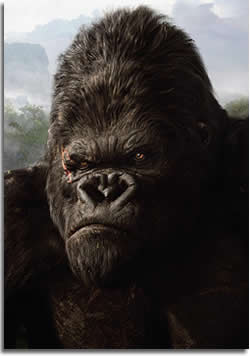 When you watch the Peter Jackson version of KING KONG, you'll be awestruck by the outrageous, wild-and-wooly visuals, where the realism of King Kong's movements, facial expressions and fighting abilities will make you wonder if maybe Jackson shot real gorillas on film, then translated those movements into CGI animation. But nope, he didn't. Instead he had British actor Andy Serkis, in a sense, recreate Chinese martial arts history.
When you watch the Peter Jackson version of KING KONG, you'll be awestruck by the outrageous, wild-and-wooly visuals, where the realism of King Kong's movements, facial expressions and fighting abilities will make you wonder if maybe Jackson shot real gorillas on film, then translated those movements into CGI animation. But nope, he didn't. Instead he had British actor Andy Serkis, in a sense, recreate Chinese martial arts history.
Serkis, who is known for being the face, voice and body language behind the Gollum in Jackson's LORD OF THE RINGS, spent a year preparing for the part. He spent two months at the London Zoo, then did a stint in Rwanda's lush Virunga Mountains for the remainder of the year, studying mountain gorilla behavior. His goal was to bring to King Kong a realistic range of gorilla emotions, responses and body movements, which were then motion-captured and processed into computer-generated images.
"I first spent a lot of time working in the Regent's park Zoo with four gorillas there; three females and one male," Serkis says. "As it turns out, one of the female gorilla's, Zaire, took a liking to me, which of course didn't go over well with the male gorilla Bongo, who'd beat his cage with his fists every time he'd see me.
"What's interesting is that gorillas in captivity reflect more human behavioral traits than in the wild because naturally in captivity they're surrounded by humans since birth.
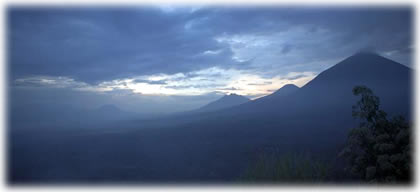
"But then I had a chance to go to Rwanda and observe them in the wild, which is another thing altogether; and over there I became part of 23 animals, beautiful gorillas, 10,000 feet up in the Virunga Volcanoes. It was magical, nothing between you and them. I was with the Dian Fossey Gorilla Fund International, who monitors their welfare."
Serkis explains that the filmmakers of the 1933 version of KING KONG were not out to understand gorillas, pointing out that to them Kong was just a monster; so things like having Kong walk around on his hands, eat humans and beat his chest with his fists became part of America's mis-information about gorillas.
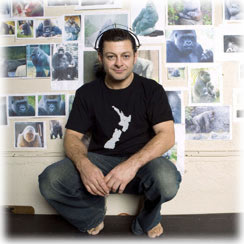 "Gorillas walk around on their knuckles and feet, are herbivores and actually beat their chest with cupped hands," says Serkis in regard to his observations. "And they can beat their hands 17 times a second. One of the silverbacks in Rwanda charged me and it really took me by surprise, because it was just so fast. It went from naught (zero) to 60 in nothing. It can be quite scary, but in the end it's really all about posturing. And isn't that what we do when we copy the animal, copy their postures?"
"Gorillas walk around on their knuckles and feet, are herbivores and actually beat their chest with cupped hands," says Serkis in regard to his observations. "And they can beat their hands 17 times a second. One of the silverbacks in Rwanda charged me and it really took me by surprise, because it was just so fast. It went from naught (zero) to 60 in nothing. It can be quite scary, but in the end it's really all about posturing. And isn't that what we do when we copy the animal, copy their postures?"
As we'd say in England, "Spot on." The font of martial arts began around A.D. 520 when a monk name Ta Mo journeyed from India to China to spread the word of Buddha. After arriving at the Songshan Shaolin Temple in Henan province, he devised what is called the "18 Buddhist fists," based on his observations of wild animals he encountered while traversing the mountains and jungles of China and India.
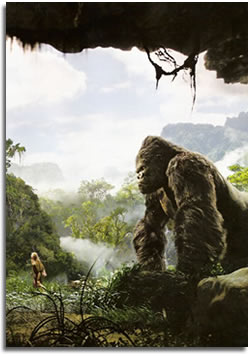 Then towards the end of the Ming Dynasty (1368-1644), while Shaolin monk Zhue Yang wandered around China, he met martial artists Li Sou and Bai Yu-feng. Together, they returned to Songshan and improved upon Ta Mo's 18 movements to create the Five Animals style of Shaolin, which combined their observations and theories of the animal fighting strategies of the dragon, tiger, leopard, snake and white crane.
Then towards the end of the Ming Dynasty (1368-1644), while Shaolin monk Zhue Yang wandered around China, he met martial artists Li Sou and Bai Yu-feng. Together, they returned to Songshan and improved upon Ta Mo's 18 movements to create the Five Animals style of Shaolin, which combined their observations and theories of the animal fighting strategies of the dragon, tiger, leopard, snake and white crane.
Although over the years these movements have either been improved upon or used in different styles, many other animal fighting techniques have arisen independently. The monkey style of martial arts is one of them.
In its purest form, monkey kung fu was developed in the late 1800s by a man named Kou Sze. Arrested for killing a villainous rascal, he was sentenced to 10 years in a prison located in a forest on the outskirts of town. His cell window faced a woodland of tall trees, which harbored a colony of chattering monkeys. Fascinated by the simian's playful antics among the trees, Kou Sze carefully studied their behaviors in different situations and, after several years, was able to distinguish the different characteristics of individual monkeys. He paid particular attention to how the apes fought and based his new unusual hopping and squatting defense system on a number of maneuvering principles which included agility, grabbing, falling, lunging, jumping and tumbling. Its mental characteristics include sneakiness, unpredictability, deviousness, elusiveness, and destructiveness.
Upon his release, Kou became known as "The Monkey Master."
However, prior to Kou, there have been several other instances where the monkey has reared up and beat its chest in the annals of Chinese martial arts history.
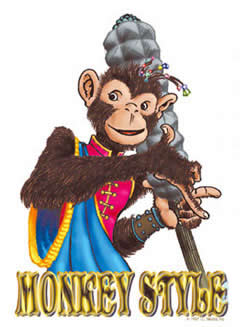 During the Han Dynasty (206 B.C. - A.D. 220) there are three events that cite the existence of monkey martial arts: A martial artist named Tan Chang-qing apparently demonstrated monkey fighting maneuvers while drunk; a silk painting entitled "a bathing monkey calls" depicts monkey style fist; and a physician named Hua Ta created a system of healing, based on breathing exercises and physical movements, called the "Five Animal Frolics," which included the Tiger, Bear, Crane, Deer and the Monkey.
During the Han Dynasty (206 B.C. - A.D. 220) there are three events that cite the existence of monkey martial arts: A martial artist named Tan Chang-qing apparently demonstrated monkey fighting maneuvers while drunk; a silk painting entitled "a bathing monkey calls" depicts monkey style fist; and a physician named Hua Ta created a system of healing, based on breathing exercises and physical movements, called the "Five Animal Frolics," which included the Tiger, Bear, Crane, Deer and the Monkey.
In the Song dynasty (A.D. 960 - 1279), Yan Ching added monkey techniques to his Mi Zhong Yi or Lost Path style. The Great Emperor Tai Tsu created the Long Fist style (Northern Shaolin) and a monkey style.
During the Yuan dynasty (1260-1380), Shaolin monk Bai Yi-feng combined monkey style with four other arts to form Ng Chor Kuen or the Five Ancestors Fist.
In the Ming dynasty (1368 - 1644), Chinese army general Chi Ji-guang mentioned monkey as a contemporary style in his "New Book of Discipline."
After Ah Dat-ta was ordained as a Buddhist Lama monk around 1455 in Tibet, he retreated to the mountains to live in seclusion and study Buddhist texts and practice meditation as a means of improving his martial arts abilities. One day Ah's meditation was disturbed by a loud sound. He emerged from his cave to see a large ape trying to capture a white crane. From this, Ah developed white crane martial arts when he observed how the white crane easily alluded and defeated a large ape bent on trying to kill it.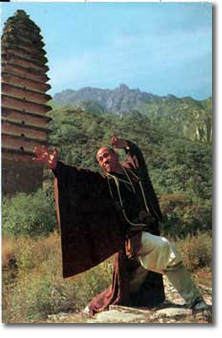
In 1564 Governor Zheng Ruo-zeng wrote the chapter "The 36 Tactics of the Monkey Style" in his book "Posting as Governor South of the Yangtze River."
During the Ching Dynasty (1644-1911), around 1656, Wang Lung added in a system of monkey footwork to his praying mantis kung fu after a day spent chasing a monkey (impressed by the way the monkey rolled, dashed, jumped, turned and trotted among the trees).
In the late 1800's northern Shaolin monk Lee Shao-hau developed a style of monkey kung fu known as the Angry Monkey, which he developed from six theories of fighting from various monkey fighters of his day.
The folklore behind the creation of the Indonesian-Malaysian martial art of pencak-silat was also "pioneered" by monkeys. One legend from the small island of Bawean on the North coast of Java tells that while young maiden Rama Sukana was washing her clothes at the river, she watched a monkey repeatedly attack another monkey with a tree branch. She gaped at how the one monkey jumped and moved aside to easily avoid the branch. She was so enamored that she forgot the time, and got home late without finishing the laundry. In anger, her husband proceeded to beat her up. However, she copied the monkey's movements and avoided all his attacks. Tiring, her husband grew impressed; and after he learn about her story, they devised the art known as seni silat.
Also of interest, the whole precept of Thai kickboxing is based on the legendary battles of the Monkey King, Hanuman, from the Indian literary classic "Ramayana." The story is based on 24,000 verses of Sanskrit, orally passed down for 5,000 years, first written in story form by the poet Valkimi in A.D. 200 and made into an animated feature film PRINCE OF LIGHT in 2001. The film was an enchanting tale of undying love and loyalty where the hero Ram and his brother Lakshaman sought the help of Hanuman, to help them rescue Ram's wife Seta from the clutches of the dastardly King Ravan.

What's curious about Hanuman is that he can fly, fight and change heights similar to Swuin Wu-kung, the Monkey King featured in the Chinese classic novel "Xi Yo Ji" ("Journey to the West") written by Wu Cheng An, 1300 years after Valmiki's version of "Ramayana."
Swuin Wu-kung is arguably the most important character featured in Beijing opera. The novel "Journey to the West" chronicles how Swuin Wu-kung, along with his kung fu brothers Zhu Ba-jie (a rake-wielding pig) and Xia Wu-jing (a "monk spade"-brandishing creature), accompany and protect a Buddhist monk named Tang San-tsang on his journey to India to obtain special sacred scriptures.
 As is common with Chinese martial arts cinema, many films and story plots are based on history and novels. Ironically, Swuin Wu-kung first appeared in film as a feature-length Japanese anime cartoon in 1961 under the moniker of SAIYUKI. Released in America as ALAKAZAM THE GREAT, it was the third Japanese cartoon ever made in color and the first anime animation film to come to America (ASTROBOY was the fourth anime feature to hit stateside in 1964).
As is common with Chinese martial arts cinema, many films and story plots are based on history and novels. Ironically, Swuin Wu-kung first appeared in film as a feature-length Japanese anime cartoon in 1961 under the moniker of SAIYUKI. Released in America as ALAKAZAM THE GREAT, it was the third Japanese cartoon ever made in color and the first anime animation film to come to America (ASTROBOY was the fourth anime feature to hit stateside in 1964).
The first Chinese cinematic installment about Swuin was a 4-part film series produced by Shaw brothers and directed by Ho Meng-hua (THE FLYING GUILLOTINE; 1976). Each film covered different parts of the novel: In MONKEY GOES WEST (1966), Swuin was played by Yueh Hua (the drunkard in COME DRINK WITH ME, directed by King Hu and starring Cheng Pei Pei); in the second installment, PRINCESS IRON FAN (1966), Yuen Hua reprised his role as Swuin and played opposite Cheng Pei Pei; in part three, CAVE OF THE SILKEN WEB, Chow Lung-cheung plays Swuin, who battles a coven of sexy spider vixens; and finally in LAND OF MANY PERFUMES (1968), Chow reprises his role as Swuin where the Monkey King and his pals are trapped in a land populated by beautiful sex-starved women.
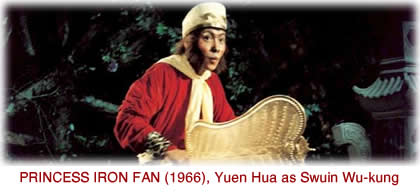
Since these films were completed, remakes, TV series and cartoon adaptations about or influenced by the "Journey to the West" have been popping up every few years. Perhaps the most recognizable to American tots and teens is the Japanese manga and animation series DRAGON BALL and DRAGON BALL Z, both heavily influenced by the novel.
 But when we're talking about the great ape, King Kong, he first appeared on screen in 1933. By the early 1930's, as Hollywood tried to tap into the success of Sir Arthur Conan Doyle's THE LOST WORLD (1925), co-producers and directors Merian Cooper and Ernest Schoedsack convinced Fay Wray to appear in their $670,000 budgeted film by saying she would play opposite "the tallest, darkest leading man in Hollywood" (Wray believed it was going to be Cary Grant). The result was the $10 million box office success, with Wray starring alongside a 60-foot gorilla.
But when we're talking about the great ape, King Kong, he first appeared on screen in 1933. By the early 1930's, as Hollywood tried to tap into the success of Sir Arthur Conan Doyle's THE LOST WORLD (1925), co-producers and directors Merian Cooper and Ernest Schoedsack convinced Fay Wray to appear in their $670,000 budgeted film by saying she would play opposite "the tallest, darkest leading man in Hollywood" (Wray believed it was going to be Cary Grant). The result was the $10 million box office success, with Wray starring alongside a 60-foot gorilla.
Due to KING KONG's success, the not-as-popular sequel SON OF KONG was shot in 1933. Partially inspired by the 1933 KING KONG fight scene between King Kong and a T-Rex, Toho studios pitted their T-Rex-ish money-maker Godzilla against King Kong in the 1962 film KING KONG VS GODZILLA. King Kong returns to the Japanese screen in 1967 with KING KONG ESCAPES, where he battles a giant robot version of himself. This film resulted as part of a licensing deal between Toho and Rankin/Bass, where Rankin/Bass got permission to make their 1966 KING KONG TV cartoon series if they promised to help Toho produce a second King Kong film.
King Kong didn't return to American cinema until 1976, with Dino DeLaurentiis' $23 million semi-flop KING KONG, which featured Jessica Lange in her screen debut. The sequel to this film, KING KONG LIVES (1986), was a major flop, starring Linda Hamilton and featuring Lady Kong.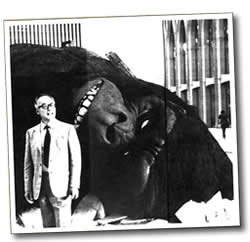
Even while the 1976 KING KONG was being shot in Hollywood, on the other side of the Pacific, Shaw Brothers was producing their own version of a King Kong film, THE MIGHTY PEKING MAN (1977), which featured Yuen Cheung-yan (Yuen Woo Ping's brother) and Yuen Bing (Jackie Chan's fellow opera classmate and one of the Seven Little Fortunes) sharing time in the giant ape suit.
.
Peter Jackson's KING KONG began development in 1996, but because of the MIGHTY JOE YOUNG and GODZILLA remakes, Universal and Miramax films pulled the plug. Ironically, back then, Jackson's salary to make the film was $6.4 million; but because of his LORD OF THE RINGS success, Universal is now paying him $20 million with 20% of the net profits. Jackson's new $120 million KING KONG is a great remake of a classic, where he's pretty much kept the look and feel of the original story, added in scenes we wish could have been in the original, along with enough new twists to avoid any predictability. The souped-up action sequences are gross, freaky, far-out, eye-popping and just plain fun to watch. The monkey fight scenes are psychotic, frenetic and insane, and really give justice to the fighting movements and behaviors of an ape.
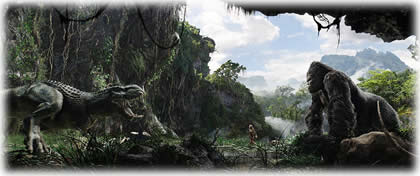
I guess we could call Andy Serkis, who also appears in the film as a human character, the British Kou Tze.
About
Dr. Craig Reid :
![]() Written by Dr. Craig Reid for KUNGFUMAGAZINE.COM
Written by Dr. Craig Reid for KUNGFUMAGAZINE.COM
![]() Print Friendly Version of This Article
Print Friendly Version of This Article
















